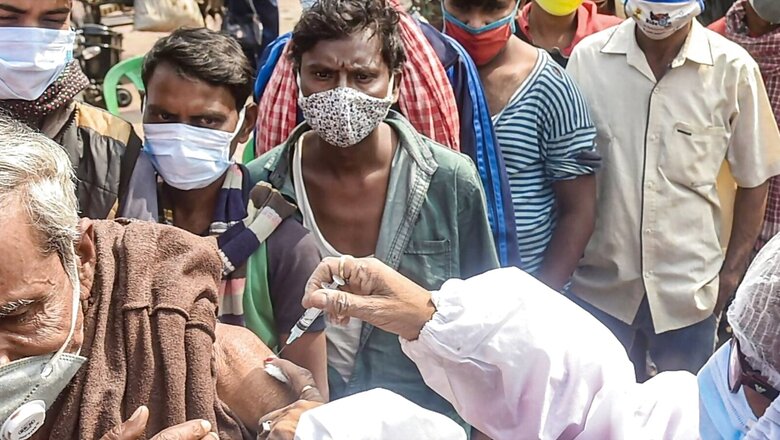
views
After going through the third wave of Covid-19 pandemic, it would be intriguing to watch what the Union Budget 2022-23 has in store for the country’s healthcare sector. The ongoing pandemic has highlighted the deficiencies of our healthcare system. Although the crisis has posed various challenges for the country and its people, it has also provided us with an opportunity to dig deep within and work towards improving the state of public health. Finance minister Nirmala Sitharaman will soon be announcing the Union Budget 2022-23. We take this opportunity to reflect upon last year’s budget and what the upcoming budget should be prioritising in the healthcare domain.
A Look at Last Year’s Budget
Last year’s health budget was released as a ‘Health and Wellness’ budget with a supposedly 137% increase in allocation as compared to the previous one. The increase was not as dramatic as it was made to be. If we exclude funding for water, sanitation, nutrition, and one-time funds for Covid-19 vaccines, the increase is only 12%. Additionally, the money allocated for 2021-22 is less than what we actually spent in 2020-21. In 2020-21, the public health expenditure formed 1.1% of GDP — an increase from 0.9% in 2015-16. It is a far cry from the 2.5% of the GDP we have envisioned time and again and as recently in the National Health Policy of 2017.
The Economic Survey of 2020-21 observed that India ranks 179th among 189 countries in prioritising healthcare in the government budget. While increasing the budget allocation for health is something we should aim for, we also have to take into account the gap between our current health status and our aspirations and where the healthcare stands in our societal priorities.
India’s Healthcare Spend Compared to Others
India’s total healthcare spending is lower than other developing countries, let alone the developed ones. Sri Lanka spends three times more than India while Indonesia spends twice in terms of per capita public expenditure. Presently, India is amongst the lowest of all BRICS (Brazil, Russia, India, China, and South Africa) and Organization for Economic Co-operation and Development (OECD) countries. According to an Oxfam survey of 2020, India spends less on health as a per cent of their GDP than Burundi – the third poorest nation in the world.
Consequences of Low Health Spending
The most evident consequence of inadequate spending in the healthcare sector is reflected in the huge disease burden in our country attributed largely due to inadequate availability of health services. There is a massive shortfall in public health infrastructure in India like Primary Health Centres, secondary and tertiary healthcare infrastructure. These shortages have become more evident in the past two years. Several lives could have been saved if there were sufficient availability of beds, oxygen and essential medicines. With limited resources available, it is only a very small chunk of the population who gets access to healthcare, making others vulnerable without any safety net. The low spending is also a cause of poor indicators such as infant and maternal mortality rate, stunting, wasting, low life expectancy, and years lost due to disability. Low allocation to healthcare also increases out of pocket expenditure by people. Out-of-pocket expenditure as a share of health spending is over 65% in India when compared to other countries such as China (32%), Sri Lanka (38%), Thailand (11%) and Nepal (60%) (OECD/WHO, 2018)
Low Budget and the Pandemic World
Healthcare is out of reach for the people who need it the most. Several diseases such as tuberculosis and cholera are called diseases of poverty because of the high percentage of poor people getting them. But the Covid-19 virus affected everyone irrespective of their socioeconomic status. This got a spotlight on the dismal state of the public healthcare infrastructure in the country. The consequences of low spending on the health sector were borne by many. This is a major opportunity to move away from chronic underinvestment. However, it appears that India has failed to seize the opportunity to significantly augment its health budget and strengthen its ailing public health infrastructure.
What Should the Health Budget Entail?
In India, health issues are mostly given importance during a crisis. Band aids are applied to stop the ongoing damage. Insufficient preparation is made to prevent the disasters and the majority of the measures are actually damage mitigation. The government should focus on improving preventive and primary healthcare of the country. With our limited capacity and infrastructure, the emphasis should be on areas where we can make the biggest difference such as nutrition, immunisation and maternal and child health with increased allocations to POSHAN 2.0 and reproductive and child health programmes.
More of the budget should be allocated to people such as the migrant population, people with geographic and demographic difficulties who are unable to access basic healthcare services. This is a subset of the population, which can benefit from even the most basic healthcare services.
Surveillance, Data Analysis and Telemedicine
The government needs to increase the budget for disease surveillance and data analysis. Provisions have to be made to collect data from existing healthcare infrastructure, collate it and release it to the public. As more data becomes available in the public domain, private players would be more efficiently able to bridge the gap. Increasing allocation to the National Digital Health Mission is a possible step in the process.
Furthermore, a significant percentage of the health budget should be committed to and aimed towards expanding the country’s telemedicine sector. With digital health initiatives, the country’s primary healthcare challenges can be overcome. With adequate investment, India can progress towards being a tech-enabled healthcare provider.
Monitoring Covid-19 Disease
India has to increase its Covid-19 disease surveillance and keep money aside for the possibility of two rounds of booster doses.
In India, only 0.2% of total samples are genetically analysed. It is critical that this be increased to at least 5%, as recommended by WHO. Genetic analysis is important to map the virus and its interaction with the human body. Analysis also helps us identify new variants and be prepared for them. With a possibility of new waves and infections in the future, India must invest more in genomic research and surveillance.
Similar to the previous year’s budget, India must set aside a special sum for the vaccination programme. The country has only recently started administering boosters. A large budget is required to maintain the pace of the vaccination campaign and to cover the possibility of a second round of booster doses.
To improve the health of India, the government should use the Budget 2022-2023 as an opportunity.
Mahek Nankani is Assistant Program Manager, and Harshit Kukreja is Research Analyst at The Takshashila Institution. The views expressed in this article are those of the authors and do not represent the stand of this publication.
Read all the Latest Opinions here



















Comments
0 comment